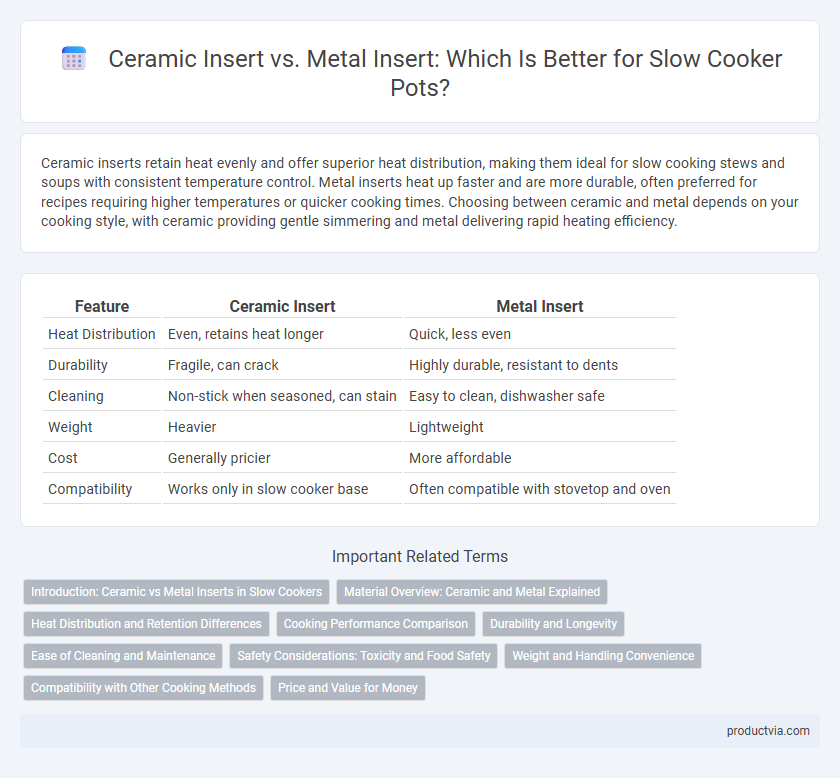Ceramic inserts retain heat evenly and offer superior heat distribution, making them ideal for slow cooking stews and soups with consistent temperature control. Metal inserts heat up faster and are more durable, often preferred for recipes requiring higher temperatures or quicker cooking times. Choosing between ceramic and metal depends on your cooking style, with ceramic providing gentle simmering and metal delivering rapid heating efficiency.
Table of Comparison
| Feature | Ceramic Insert | Metal Insert |
|---|---|---|
| Heat Distribution | Even, retains heat longer | Quick, less even |
| Durability | Fragile, can crack | Highly durable, resistant to dents |
| Cleaning | Non-stick when seasoned, can stain | Easy to clean, dishwasher safe |
| Weight | Heavier | Lightweight |
| Cost | Generally pricier | More affordable |
| Compatibility | Works only in slow cooker base | Often compatible with stovetop and oven |
Introduction: Ceramic vs Metal Inserts in Slow Cookers
Ceramic inserts in slow cookers provide even heat distribution and excellent heat retention, making them ideal for slow, consistent cooking and easy cleaning due to their non-reactive surface. Metal inserts, typically made of stainless steel or aluminum, heat up faster and are more durable, resistant to chipping and cracking, but may result in less uniform cooking compared to ceramic. Choosing between ceramic and metal inserts depends on your cooking preferences, with ceramic favoring gentle, steady heat and metal offering durability and speed.
Material Overview: Ceramic and Metal Explained
Ceramic inserts in slow cookers offer excellent heat retention and even distribution, creating a gentle cooking environment ideal for soups and stews, while their non-reactive surface prevents flavor alteration. Metal inserts, typically stainless steel or aluminum, heat up faster and are more durable against chips and cracks but may cause uneven heating without proper design. Choosing between ceramic and metal depends on cooking style preferences, with ceramic favoring slow, consistent simmering and metal suited for quicker heat response.
Heat Distribution and Retention Differences
Ceramic inserts provide superior heat retention, maintaining consistent temperatures for longer cooking cycles, while metal inserts heat up faster but cool down more quickly. The even heat distribution of ceramic minimizes hot spots, reducing the risk of burning or uneven cooking compared to metal, which can have less uniform heat spread. Choosing between ceramic and metal inserts depends on the importance of steady heat versus quicker temperature adjustments in slow cooking.
Cooking Performance Comparison
Ceramic inserts in slow cookers provide even heat distribution and excellent heat retention, resulting in consistent cooking and better moisture retention for tender dishes. Metal inserts, typically aluminum or stainless steel, heat up faster but may cause uneven cooking or hot spots, potentially affecting the texture of delicate ingredients. Overall, ceramic pots are preferred for slow, steady cooking, while metal inserts offer quicker temperature responsiveness suitable for faster recipes.
Durability and Longevity
Ceramic inserts for slow cooker pots offer excellent heat retention and resist scratching, but they are more prone to chipping and cracking over time compared to metal inserts. Metal inserts, typically stainless steel or aluminum, provide superior durability and withstand frequent use and accidental drops without damage. For longevity, metal inserts generally outperform ceramic, maintaining their structural integrity through extensive daily cooking.
Ease of Cleaning and Maintenance
Ceramic inserts in slow cookers offer a non-porous, smooth surface that resists staining and odor retention, making them easier to clean and maintain compared to metal inserts. Metal inserts, often made of stainless steel or aluminum, can be durable but may require more scrubbing to remove stuck-on food and can discolor over time. Ceramic inserts are generally dishwasher safe, providing convenience, while metal inserts might demand hand washing to preserve their finish.
Safety Considerations: Toxicity and Food Safety
Ceramic inserts for slow cookers are non-toxic, non-reactive, and free from harmful chemicals like lead or cadmium, ensuring safer food preparation. Metal inserts, typically stainless steel or aluminum, may pose concerns if damaged or if low-quality materials leach into food, especially when exposed to acidic ingredients. Prioritizing insert materials certified for food safety and resistance to corrosion reduces risks of toxicity and contamination during slow cooking.
Weight and Handling Convenience
Ceramic inserts for slow cooker pots are heavier, providing excellent heat retention but requiring more effort during handling and cleaning. Metal inserts, often made of stainless steel or aluminum, are lighter and easier to maneuver, offering greater convenience when transferring or washing. Choosing between ceramic and metal inserts depends on the balance between heat performance and ease of use for your slow cooking needs.
Compatibility with Other Cooking Methods
Ceramic inserts for slow cookers offer excellent heat retention and are often oven-safe, allowing seamless transition from slow cooking to baking or broiling. Metal inserts, typically made of stainless steel or aluminum, provide superior compatibility with stovetop use and higher durability for searing or sauteing before slow cooking. Choosing between ceramic and metal inserts depends on the desired versatility, with ceramic favoring gentle, even heating and metal suited for multi-method cooking applications.
Price and Value for Money
Ceramic inserts for slow cooker pots typically cost more upfront but offer superior heat retention and even cooking, enhancing overall value for money through durability and food quality. Metal inserts, often made of aluminum or stainless steel, are less expensive and lighter but may conduct heat less evenly, which can affect cooking performance and long-term value. Choosing between ceramic and metal inserts depends on balancing initial price with cooking efficiency and longevity for the best cost-effectiveness.
Ceramic insert vs Metal insert for slow cooker pots Infographic

 productvia.com
productvia.com